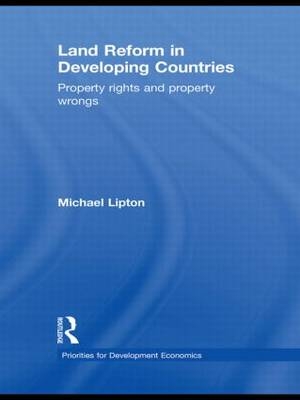
Land Reform in Developing Countries
Property Rights and Property Wrongs
Seiten
2009
Routledge (Verlag)
978-0-415-09668-3 (ISBN)
Routledge (Verlag)
978-0-415-09668-3 (ISBN)
- Titel ist leider vergriffen;
keine Neuauflage - Artikel merken
Redistributing land rights is a tricky subject and one that easily becomes controversial as recent experience has shown. This new book calmly examines the strengths and weaknesses of different forms of land redistribution.
Land reforms are laws that are intended, and likely, to cut poverty by raising the poor’s share of land rights. That raises questions about property rights as old as moral philosophy, and issues of efficiency and fairness that dominate policy from Bolivia to Nepal. Classic reforms directly transfer land from rich to poor. However, much else has been marketed as land reform: the restriction of tenancy, but also its de-restriction; collectivisation, but also de-collectivisation; land consolidation, but also land division.
In 1955-2000, genuine land reform affected over a billion people, and almost as many hectares. Is land reform still alive, for example in Bolivia, South Africa and Nepal? Or is it dead and, if so, is this because it has succeeded, or because it has failed? There has been massive research on land reform and this book builds on some surprising findings.
Small farms’ share in land is rising in most of Asia and Africa.
This is not driven (as widely claimed) by growth in rural population or farm productivity, but by the relative efficiency of small farms, and in some cases by land reform.
Whether land reform helps the poor depends not only on land transfers, but at least as much on its effects through employment, non-farm activity, GDP growth and distribution, as well as the village status and power of the poor.
Avoidance, evasion and even distortion of land reform laws sometimes advance their main aims.
Liberalisation and its accompaniments (such as supermarkets) can be powerful friends or fatal foes of small farms and land reform.
This book will be of great interest to students, researchers and consultants working on agriculture, farm organisation, rural development and poverty reduction, with special emphasis on developing countries.
Land reforms are laws that are intended, and likely, to cut poverty by raising the poor’s share of land rights. That raises questions about property rights as old as moral philosophy, and issues of efficiency and fairness that dominate policy from Bolivia to Nepal. Classic reforms directly transfer land from rich to poor. However, much else has been marketed as land reform: the restriction of tenancy, but also its de-restriction; collectivisation, but also de-collectivisation; land consolidation, but also land division.
In 1955-2000, genuine land reform affected over a billion people, and almost as many hectares. Is land reform still alive, for example in Bolivia, South Africa and Nepal? Or is it dead and, if so, is this because it has succeeded, or because it has failed? There has been massive research on land reform and this book builds on some surprising findings.
Small farms’ share in land is rising in most of Asia and Africa.
This is not driven (as widely claimed) by growth in rural population or farm productivity, but by the relative efficiency of small farms, and in some cases by land reform.
Whether land reform helps the poor depends not only on land transfers, but at least as much on its effects through employment, non-farm activity, GDP growth and distribution, as well as the village status and power of the poor.
Avoidance, evasion and even distortion of land reform laws sometimes advance their main aims.
Liberalisation and its accompaniments (such as supermarkets) can be powerful friends or fatal foes of small farms and land reform.
This book will be of great interest to students, researchers and consultants working on agriculture, farm organisation, rural development and poverty reduction, with special emphasis on developing countries.
Michael Lipton has worked since 1960 as a development economist. He was based for 25 years at the Institute of Development Studies, for three years directed the Sussex University Poverty Research Unit, and remains research professor at Sussex.
Introducing Land Reform 1. Goals 2. Output, Efficiency and Growth 3. Land Reforms: The Types, and the Classic Paradigm 4. Tenurialism: Tenancy Reform, Titling, Patrialisation 5. The Terrible Detour: Collectivisation and Decollectivisation 6. Alternatives, Complements, Diversions, ‘New Wave’ Land Reform 7. The Death of Land Reform?
| Erscheint lt. Verlag | 24.6.2009 |
|---|---|
| Reihe/Serie | Priorities for Development Economics |
| Verlagsort | London |
| Sprache | englisch |
| Maße | 156 x 234 mm |
| Themenwelt | Sozialwissenschaften |
| ISBN-10 | 0-415-09668-5 / 0415096685 |
| ISBN-13 | 978-0-415-09668-3 / 9780415096683 |
| Zustand | Neuware |
| Haben Sie eine Frage zum Produkt? |
Mehr entdecken
aus dem Bereich
aus dem Bereich
Grundlagen - Technik - Einsatz
Buch | Hardcover (2023)
Kohlhammer (Verlag)
CHF 124,60
Praxiswissen für Gruppenführer
Buch | Softcover (2023)
Kohlhammer (Verlag)
CHF 58,75


